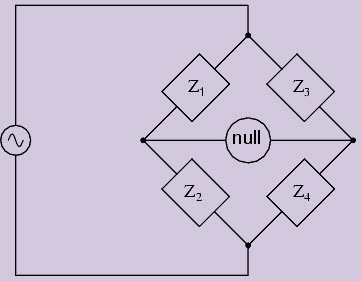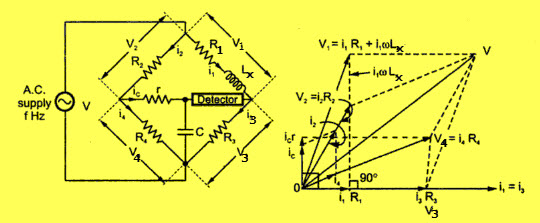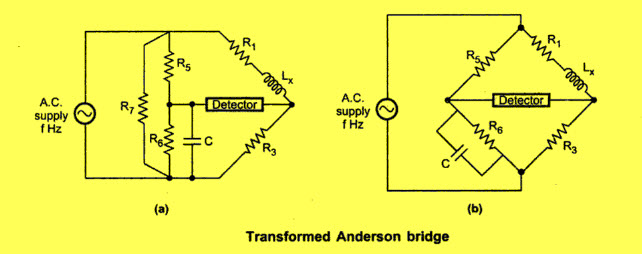The bridge circuits are used to measure various component values
like resistance, capacitance, inductance etc. The simple form of a
bridge circuit consists of a network of four resistances/impedance arms
that forms a closed circuit. A current source is applied to two opposite
nodes and a current detector is connected to remaining two nodes. This
article discusses Andersons bridge circuit working and its applications.

The bridge circuits use the null
indication principle and comparison measurement method, this is also
known as “Bridge Balance condition at zero voltage. The bridge circuit
compares the values of an unknown component with that of an accurately
known standard component. Thus, the accuracy mostly depends on the
bridge circuit, not on the null-indicator.
From the above bridge circuit, the balancing equation is

Different Types of Bridges
Two types of bridges used to measure the component values. They are D.C bridges and A.C bridges.
D.C Bridges are
- Wheatstone bridge
- Kelvin bridge
The various types of A.C Bridges are,
- Inductance comparison bridge
- Capacitance comparison bridge
- Maxwell’s bridge
- Hay’s bridge
- Anderson’s bridge
- Schering bridge
- Wien bridge
A.C Bridges
AC bridges are often used to measure the
value of unknown impedance (self/mutual inductance of inductors or
capacitance of capacitors accurately). An A.C bridge circuit consists of
four impedances, a source of A.C supply and a balanced detector. The
balance detectors generally used for A.C bridges are
- Headphones (at the frequencies of 250 Hz to 3 to 4 kHz)
- Tunable amplifier circuit (for frequency range of 10HZ to 100Hz)
- Vibration galvanometers (for low range frequency from 5Hz to 1000 Hz)
The null response (bridge balance
condition) can be obtained by varying one of the bridge arms. The
impedance of a component is in a form of polar that can have a magnitude
and a phase angle value. For an A.C circuit shown above, the impedance
can be written in terms of magnitude and phase angle

Where Z1, Z2, Z3, Z4, are the magnitudes
and θ1, θ2, θ3, and θ4 are phase angles. The product of all impedances
must be carried out in the polar form where all magnitudes get
multiplied and phase angles should be added.

Here, the bridge must be balanced for
both the conditions magnitude as well as phase angles. From the above
equations two conditions to be satisfied for the bridge balance.
Equating magnitudes of both sides, we will get the magnitude condition
as,
Z1.Z4=Z2.Z3
And the phase angles also, θ1+ θ4= θ2+ θ3
The phase angle is +ve inductive impedances and –ve for the capacitive impedances.

Andersons Bridge Construction and Working
The Anderson’s Bridge is an A.C bridge
used to measure the self-inductance of the coil. It enables to measure
the inductance of a coil using a standard capacitor
and resistors. It does not require repeated balancing of the bridge. It
is a modification of Maxwell’s Bridge in which also the value of
self-inductance is obtained by comparing it with a standard capacitor.
The connections are shown below.

One arm of the bridge consists of the
unknown inductor Lx with known resistance in series with Lx. This
resistance R1 includes the resistance of the inductor. Capacitance C is the standard capacitor with r, R2, R3, and R4 are non-inductive in nature.
The bridge balance equations are,
i1= i3, and i2= i4+ic,
V2= i2.R3 and V3= i3.R3
V1= V2+ic.r and V4= V3+ icr
V1=i1.R1+i1.ω.L1 and V4=i4.R4
Now the voltage V is given by,
From the above circuit, R2, R4, and r
are in star form, that are transformed into its equivalent delta form in
order to find the bridge balance equations as shown in the figure
below.

The elements in equivalent delta are given by,
R5= (R2.r+R4.r+R2.R4)/R4
R6= (R2.r+R4.r+R2.R4)/R2
R7= (R2.r+R4.r+R2.R4)/r
Now the R7 shunts the source, and hence
it does not affect the balance condition. Thus, by neglecting R7 and
rearranging a network as above fig (b), we get a Maxwell inductance
bridge.
Thus the balance equation is given by
Lx= CR3R5 and
R1=R3.(R5/R6)
Substituting the values of R5 and R6, we will get

If the capacitor used is not perfect,
the value of inductance remains unchanged, but the value of R1 changes.
The Anderson’s bridge method can also be used to measure of the
capacitor C if a calibrated self-inductance is available.
The above equation which we obtained is
more complex that we have obtained in Maxwell bridge. On observing the
above equations we can easily say that to obtain convergence of balance
more easily, one should make alternate adjustments of R1 and r in
Anderson’s bridge.
Now let us look how we can obtain the
value of the unknown inductor experimentally. At first, set the signal
generator frequency at the audible range. Now adjust R1 and r such that
the headphones (null detector) give a minimum sound. Measure the values
of R1 and r (obtained after these adjustments) with the help of the
multimeter. Use the formula that we have derived above in order to find
out the value of unknown inductance. The experiment can be repeated with
the different value of the standard capacitor.
Advantages of Andersons Bridge
- Fixed capacitor is used, whereas other bridges use a variable capacitor.
- The bridge is used for accurate determination of inductance in the millimeter range.
- This bridge also gives an accurate result for determination of capacitance in terms of inductance.
- The bridge is easy to balance from the convergence point of view compared Maxwell’s bridge in case of low values of Q.
Disadvantages of Andersons Bridge
- It is very complicated than other bridges in terms of the number of components used.
- Balance equations are also complicated to derive.
- The bridge cannot be easily shielded due to the additional junction point, to avoid the effects of stray capacitances.
Applications of Andersons Bridge
- It is used to measure the self-inductance of the coil(L)
- To find the value of inductive reactance (XL) of the coil at a specific frequency
From the above information, finally, we
can conclude that an Andersons bridge is well known for its application
measuring self-inductance from few micro Henry to several Henry
precisely. We hope that you have got a better understanding of this
concept.Furthermore, any doubts regarding this concept or to implement electrical and electronic projects please, give your valuable suggestions by commenting in the comment section below. Here is a question for you, What are the applications of AC bridges?

No comments:
Post a Comment